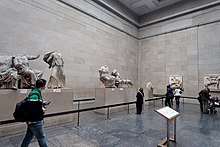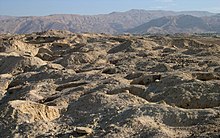Archaeological ethics
Archaeological ethics refers to the moral issues raised through the study of the material past. It is a branch of the philosophy of archaeology.

Archaeologists are bound to conduct their investigations to a high standard and observe intellectual property laws, health and safety regulations, and other legal obligations.[1] Archaeologists in the field are required to work towards the preservation and management of archaeological resources, treat human remains with dignity and respect, and encourage outreach activities. Sanctions are in place for those professionals who do not observe these ethical codes. Questions regarding archaeological ethics first began to arise during the 1960s and 1970s in North America and Western Europe. [2] A UNESCO ratification to protect world culture in 1970 was the one of the earliest actions to implement ethical standards.[2]
Human Remains
A common ethical issue in modern archaeology has been the treatment of human remains found during excavations, especially those that represent the ancestors of aboriginal groups in the New World or the remains of other minority races elsewhere.[3] In November of 1990 the Native American Graves Protection and Repatriation Act (NAGPRA) was enacted, facilitating the return of certain human remains and sacred objects to lineal descendants and Native American Tribes. [4] Where previously sites of great significance to indigenous peoples could be excavated and burials and artifacts taken to be stored in museums or sold, there is now increasing awareness of taking a more respectful approach. Technical developments in ancient DNA testing have raised more ethical questions in relation to the treatment of these human remains.[5] The issue is not limited to indigenous human remains. Nineteenth and twentieth century burial sites investigated by archaeologists, such as First World War graves disturbed by developments, have seen the remains of people with closely connected living relatives being exhumed and taken away.
.jpg)
Antiquities Trade
Although not formally connected with the modern discipline of archaeology, the international trade in antiquities has also raised ethical questions regarding the ownership of archaeological artifacts. The market for imported antiquities has encouraged damage to archaeological sites and often led to appeals for the recall.[6] Famous sites such as Angkor Wat in Cambodia have experienced problems with looting. [7] Looting often leads to loss of information as material remains are removed from their original contexts. [6] Examples of archaeological material which has been removed from its place of origin and over which there is now controversy regarding its return include the Elgin Marbles.
Nationalism
A wider question of control and ownership over the past has also been raised through the political manipulation of the archaeological record to promote nationalism and justify military invasion. A famous example is the corps of archaeologists employed by Adolf Hitler to excavate in central Europe in the hope of finding evidence for a region-wide Aryan culture. Many archaeologists in the West today are employees of national governments or are privately employed instruments of government-derived archaeology legislation. In all cases this legislation is a compromise to some degree or another between the interests of the archaeological remains and the interests of economic development. Questions regarding the ethical validity of government heritage policies and whether they sufficiently protect important remains are raised during cases such as High Speed 1 in London where burials at a cemetery at St Pancras railway station were hurriedly dug using a JCB and mistreated in order to keep an important infrastructure project on schedule.[8]
Preservation

Another issue is the question of whether unthreatened archaeological remains should be excavated (and therefore destroyed) or preserved intact for future generations to investigate with potentially less invasive technology. Some archaeological guidance such as PPG 16 has established a strong ethical argument for only excavating sites threatened with destruction. New technology such as laser scanning has pioneered non-invasive techniques for recording petroglyphs and engravings. Other technology like GPS and Google Earth has revolutionized the way archaeologists find and record potential archaeological sites. [6]
External links
References
- "NPS Archeology Program: Archeology Law and Ethics". www.nps.gov. Retrieved 2020-07-31.
- Galor, Katharina (2017), "Archaeological Ethics", Finding Jerusalem, Archaeology between Science and Ideology, University of California Press, pp. 100–116, doi:10.1525/j.ctt1pq349g.13#metadata_info_tab_contents, retrieved 2020-07-31
- Mar 2017, Michael Balter / 30 (2017-03-30). "The Ethical Battle Over Ancient DNA". SAPIENS. Retrieved 2020-07-12.
- "Native American Graves Protection and Repatriation Act (U.S. National Park Service)". www.nps.gov. Retrieved 2020-07-12.
- Nicholas, George P. (2005). "Editor's Notes: On mtDNA and Archaeological Ethics". Canadian Journal of Archaeology / Journal Canadien d'Archéologie. 29 (1): iii–vi. ISSN 0705-2006.
- Bahn, Paul (2013). Archaeology: A Very Short Introduction (2nd ed). Oxford University Press. pp. 107–108. ISBN 9780199657438.
- Perlez, Jane (2005-03-21). "A Cruel Race to Loot the Splendor That Was Angkor". The New York Times. ISSN 0362-4331. Retrieved 2020-07-31.
- Mead, Rebecca. "The Bodies Buried Beneath Boris Johnson's New Railway". The New Yorker. Retrieved 2020-07-31.